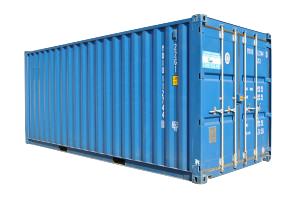
Most people are familiar with the ‘normal’ box-type shipping container – they are seen on container ships, lorry trailers, trains and stacked up at the ports. There are actually many different types of shipping container and the type you choose will depend on your specific requirement. Here is a summary of the main types and how they are specialised for their specific role. Dimensions and tare (unladen) weights are included for the most popular types.
- Dry Containers
Dry Containers are available in sizes of 10, 20, and 40 feet – 20 and 40 being the most commonly used. They are used to transport general cargo and are the most commonly known type of shipping container. Basically a metal box which opens for loading / unloading at one end. They are strong, stackable and reusable. At the end of their life they are often used for lockable storage units or even made into cheap housing.


2. Folding / Collapsible Containers
A revolutionary invention – folding / collapsible containers save on storage space and transport costs when empty. See how the Treck collapsible container works here:
3. Flat Rack Containers
Flat Rack containers are available in 20 and 40 feet and have sides that can be folded down to accommodate heavy loads, over-sized cargo, construction equipment, building supplies, or heavy machinery. Typically used for cargo that needs loading from the top of sides.


4. Open Top Containers
Open Top containers are available in 20 or 40 foot sizes and have a completely removable, convertible top that allows for access to goods from the top of the container. They are mainly used for over-height cargo. They are also available as a half-height container. Many open top containers now just have a tarpaulin-type soft cover.


5. Open Side Containers
Open side containers are available in 20 or 40 foot sizes and open on the side to facilitate specific loading and unloading requirements.

6. Tunnel Containers
Tunnel containers are identical to a dry goods container but open at each end, making loading and unloading easier and quicker.

7. Swap-Body Containers
Swap Bodies are a special kind of container mainly used in Europe. These containers are not made according to the ISO standards since they are not standardised shipping containers. However, they are provided with a strong bottom and a convertible top, which makes them extremely useful for shipping many products.

8. Refrigerated ISO Containers
Refrigerated ISO Containers (also called reefer containers) regulate the temperature to preserve temperature sensitive goods such as produce or seafood.

9. Insulated or Thermal Containers
Insulated or thermal containers come with a regulated temperature control, which allows them to withstand a higher temperature. They are most suitable for long distance transportation of products.

10. Half Height Containers
Clue is in the name! These containers are half the height of a full sized dry container and they are made mostly of steel. They are primarily used for goods like coal, stones, etc. which require easy loading and unloading. Since these containers are half sized they help keep the weight per container at a reasonable amount.

11. Car Carrier Containers
Car carriers are special container storage units made for the shipment of cars over long distances. To help a car fit snugly inside the containers without risking damage, they come with collapsible sides.

12. Tank Containers
Tanks are the container type used for the transportation of liquids and are used by a huge proportion of the shipping industry. These container types are mostly made of anti-corrosive materials which provide them with long life and protect the materials being transported.

13. Drum Containers
Drums are shipping containers that are most suitable for bulk transport of liquid materials. They are made from various materials suh as steel, fibreglass, hard plastic etc. Although they are smaller in size, they may need extra space due to their non-standard shape.


I absolutely love your blog and find most of your post’s to be what precisely I’m looking for. Would you offer guest writers to write content for you personally? I wouldn’t mind producing a post or elaborating on a few of the subjects you write about here. Again, awesome blog!
LikeLiked by 1 person
Thank you for your kind words. Yes I am now looking at guest writers and have already had a few excellent guest articles which have been published recently. Look out for more details soon!
LikeLike